前言:
从17年9月份开始断断续续的接触java开发,对java的知识体系了解甚少,都是浮在各种语法的使用上,浅尝则止,使用最多的关键字莫过于String List Map Thread,对java语法体系的内部逻辑没有深入学习过,希望通过笔记分享来加深对java的学习,知其然,知其所以然
今天要分享的知识:java并发编程-volatile、CAS、synchronize
volatile
1、保证可见性:可见性是指当多个线程访问同一个变量时,一个线程修改了这个变量的值,其他线程能够立即看得到修改的值
产生不可见的原因:cpu结构,各个cpu的cache之间数据不可见
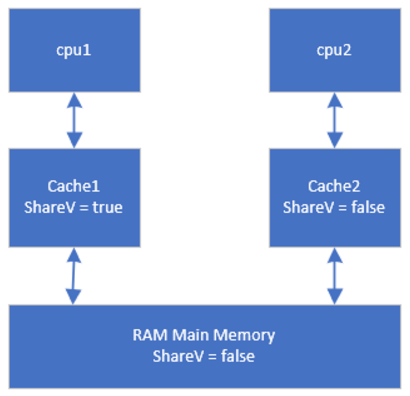
场景:共享变量ShareV = false,线程T1在cpu1上运行,将ShareV修改为true,线程T2在cpu2上运行,通过判断ShareV的值进行逻辑处理,若Cache1中ShareV没有更新到主存,Cache2中ShareV的值仍然为false,导致共享变量的值在多线程下不一致
作用:被定义为volatile的变量在Cache中发生变化时会被立即更新到主存,同时使该值在其他Cache的副本失效,Cache会从主存拉取该变量的最新值
应用实例:
public class VolatileTest { private volatile static boolean flag = false; public static void main(String[] args) { Thread write = new Thread(new Runnable() { public void run() { // TODO Auto-generated method stub flag = true; } }); Thread read = new Thread(new Runnable() { public void run() { while(true) { if(flag) { //flag保证为最新值 System.out.println("do something you want"); break; } } } }); write.start(); read.start(); } }
2、保证有序性:有序性是指在单线程中保证不影响执行结果的前提下,为了提高运行速度,编译器和CPU会将程序编译出的指令重排序,这里的有序保证的是不影响执行结果,而不一定是按照代码的编写顺序执行
重排序导致多线程不安全场景
public class SingleTon { public Integer testInt; protected SingleTon() { testInt = new Integer(1); } private static SingleTon instance; public static SingleTon getInstance() { if(instance == null) { //第一次判断 synchronized(SingleTon.class) { if(instance == null) { //第二次判断 instance = new SingleTon(); } } } return instance; } }
问题的根源:
instance = new SingleTon();创建对象时可分解为3行伪代码
memory = allocate() //1:分配对象的内存空间
ctorInstance(memory) //2:初始化对象
instance = memory //3:设置instance指向刚分配的地址
上述3行代码编译器可能会对2、3重排序,先执行3,再执行2,导致多线程不安全
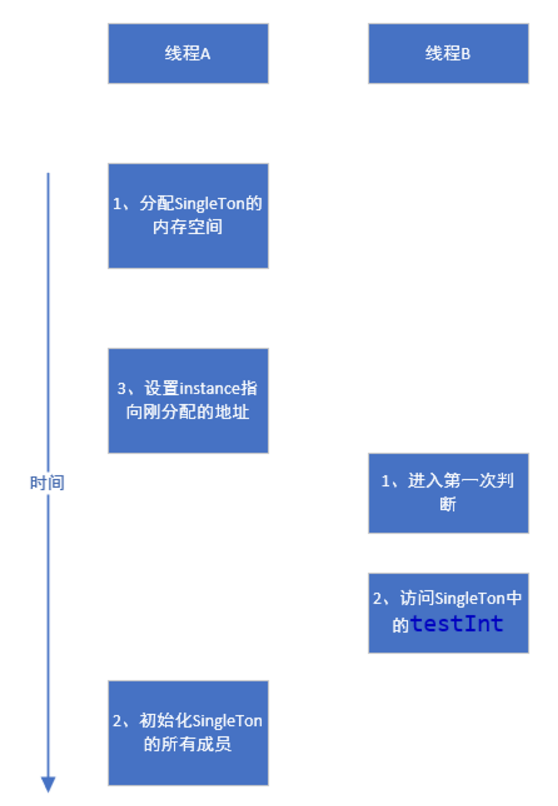
当线程B访问testInt时可能为空
将对象instance加上关键字volatile,可以保证2、3步骤不会被重排序,volatile会使编译器在生成指令时在2、3之间插入内存屏障,屏障前后的指令顺序无法交换
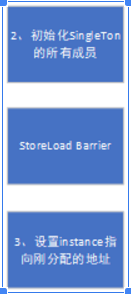
图中的插入屏障后的执行语义:SingleTon中所有的成员都保存(刷新到内存)后,才能给instance赋值
内存屏障类型表:

volatile变量插入屏障的场景:

从表中可以看出,第二个操作是对volatile变量写时,第一个操作不管是任何操作都不能重排序,第一个操作是对volatile变量读时,第二个操作不管是任何操作都不能重排序
CAS(compare and swap)
在了解cas前先了解原子操作的方式:
1、锁总线
处理器提供一个总线LOCK信号,当一个处理器在总线上输出此信号时,其他处理器的请求将被阻塞,发出信号的处理器将独占内存
2、锁缓存
处理器提供一个缓存LOCK信号,该缓存的主存所对应的其他cpu下的缓存将被锁定,只有发出信号的处理器能操作此缓存,CMPXCHG就是其中一个信号指令
CAS操作就是利用CMPXCHG指令实现的
CAS语法含义:CAS(expect,update),与期望值expect比较,如果相等,更新为update值,不等,更新失败
应用实例:
public class Counter { private AtomicInteger atomicI = new AtomicInteger(0); private volatile int i=0; private void unsafecount() { i++; } private void safeCount() { for(;;) { int i = atomicI.get(); boolean suc = atomicI.compareAndSet(i, ++i); if(suc) { break; }else { System.out.println("false....old value:"+i+"new value:"+atomicI.get()); } } } public static void main(String[] args) { final Counter cas = new Counter(); List<Thread> ts = new ArrayList<Thread>(600); for(int i=0;i<100;i++) { Thread t = new Thread(new Runnable() { public void run() { for(int i=0;i<10000;i++) { cas.unsafecount(); cas.safeCount(); } } }); ts.add(t); } for(Thread t : ts) { t.start(); } for(Thread t : ts) { try { t.join(); } catch (InterruptedException e) { // TODO Auto-generated catch block e.printStackTrace(); } } System.out.println("unsafe result:"+cas.i); System.out.println("safe result:"+cas.atomicI.get()); } }
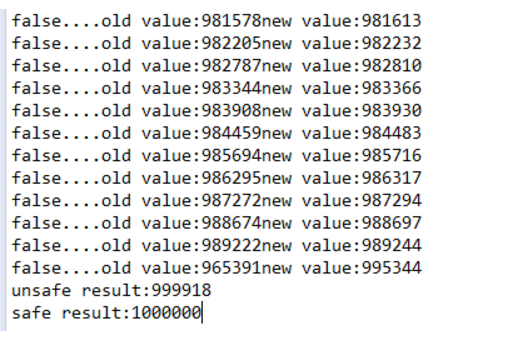
AtomicInteger部分源码:
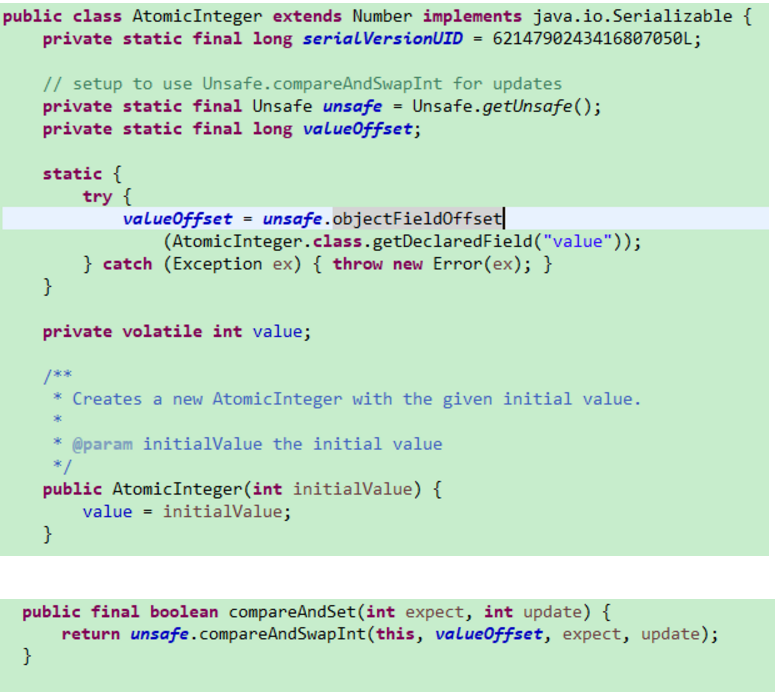
valueOffset为value的地址值
下图为使用cas对volatile int i进行多线程安全操作流程图
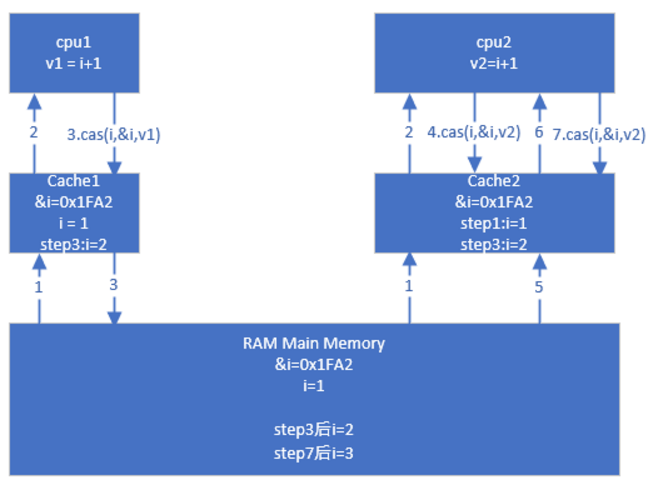
1、获取i的值
2、将i值加1赋值给v1
3、cpu2的cas操作同一个地址,被锁住;cpu1的cas 刷新到缓存,比较i(此处的i为传值操作)的值,和&i地址所指向的值,都为1,将&i地址所指向的值更新为v1,由于v1为volatile,立即刷新到主存,i值更新为2
4、cpu2的cas刷新到缓存,比较i(此处的i为传值操作)的值,和&i地址所指向的值,&i地址指向的值变为2,而传入的i值为1,不相等
5、获取i的值
6、将i值加1赋值给v2
7、cpu2的cas操作,step7后i值为3
从运行结果截图中可以看出,当cas失败时,期望的值和最新的值差值很大了,这是因为step3被执行 了多次之后,step4才被执行
结合volatile和cas是java实现原子操作的基石,整个java并发开发包concurrent都是以volatile和cas为基础开发的
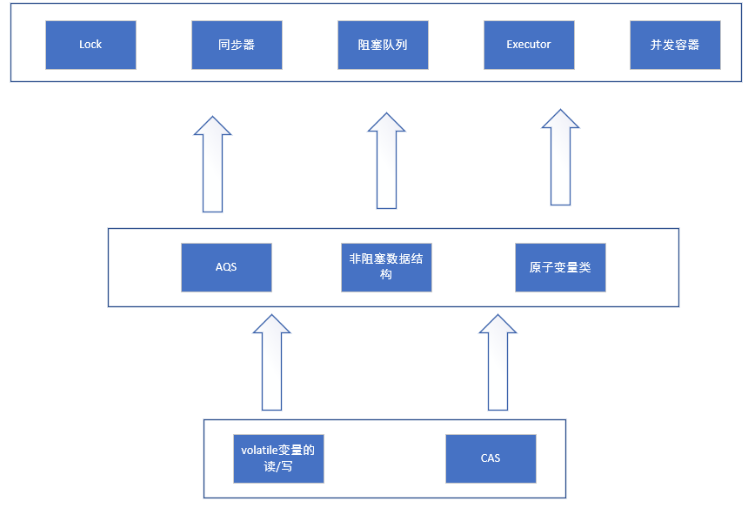
上图中还有很多并发包的知识点,希望后期能够整理成笔记
synchronize
可以保证方法或者代码块在运行时,同一时刻只有一个方法可以进入到临界区,同时它还可以保证共享变量的内存可见性
应用实例
1、锁普通方法
2、锁静态方法
3、锁方法块
public class SynchronizeTest { public synchronized void normaltest1() { System.out.println("start normaltest1....."+currentTime()); sleepSeconds(5); System.out.println("end normaltest1....."+currentTime()); } public synchronized void normaltest2() { System.out.println("start normaltest2....."+currentTime()); sleepSeconds(5); System.out.println("end normaltest2....."+currentTime()); } public synchronized static void staticTest1() { System.out.println("start staticTest1....."+currentTime()); sleepSeconds(5); System.out.println("end staticTest1....."+currentTime()); } public synchronized static void staticTest2() { System.out.println("start staticTest2....."+currentTime()); sleepSeconds(5); System.out.println("end staticTest2....."+currentTime()); } public void blockTest1() { System.out.println("start blockTest1....."+currentTime()); synchronized(this) { sleepSeconds(5); } System.out.println("end blockTest1....."+currentTime()); } public void blockTest2() { System.out.println("start blockTest2....."+currentTime()); synchronized(this) { sleepSeconds(5); } System.out.println("end blockTest2....."+currentTime()); } public static void sleepSeconds(int time) { try { Thread.sleep(time*1000); } catch (InterruptedException e) { e.printStackTrace(); } } public static String currentTime() { Date date = new Date(); SimpleDateFormat format = new SimpleDateFormat("yyyy-MM-dd HH:mm:ss"); String time = format.format(date.getTime()); return time; } public static void main(String[] args) { //1.普通方法块,锁normalst对象 final SynchronizeTest normalst = new SynchronizeTest(); Thread t1 = new Thread(new Runnable() { public void run() { normalst.normaltest1(); } }); Thread t2 = new Thread(new Runnable() { public void run() { normalst.normaltest2(); } }); t1.start(); t2.start(); //2.静态方法块,锁SynchronizeTest类对象 final SynchronizeTest staticst1 = new SynchronizeTest(); final SynchronizeTest staticst2 = new SynchronizeTest(); Thread t3 = new Thread(new Runnable() { public void run() { staticst1.staticTest1(); } }); Thread t4 = new Thread(new Runnable() { public void run() { staticst2.staticTest2(); } }); t3.start(); t4.start(); //3.代码块,锁代码块上的对象 final SynchronizeTest blockst = new SynchronizeTest(); Thread t5 = new Thread(new Runnable() { public void run() { blockst.blockTest1(); } }); Thread t6 = new Thread(new Runnable() { public void run() { blockst.blockTest2(); } }); t5.start(); t6.start(); } }
运行结果截图:

从截图可以看出,两个线程调用同一个对象的两个普通方法,其中一个线程会被阻塞,证明synchronize锁的不是方法,而是对象
synchronize锁对象的原理
java对象内存结构

markWord结构:

markWord中的数据结构会随着对象被锁的状态发生变化,java SE 1.6之前markWord的四种锁中只有无锁和重量级锁来实现锁多线程机制,但重量级锁使得程序的并发效率很低,由于synchronize性能很低,增加了偏向锁和轻量级锁进行了优化,所以我们重点讲解重量级锁
(这里面还有每种锁在什么状态下触发、锁撤销、锁升级的知识点,感兴趣的同学可以自己查下资料)
在markword中对象为重量级锁状态时,有一个指向重量级锁的指针,这个指针的值为一个Monitor对象的地址值,每个对象都有一个对应的Monitor对象
通过下面这段代码大致讲述一下获取Monitor对象的流程
public class Monitor { public void synTest() { synchronized(this) { System.out.println("hello..."); } } public static void main(String[] args) { Monitor m = new Monitor(); m.synTest(); } }
反编译字节码 javap - v Monitor.class
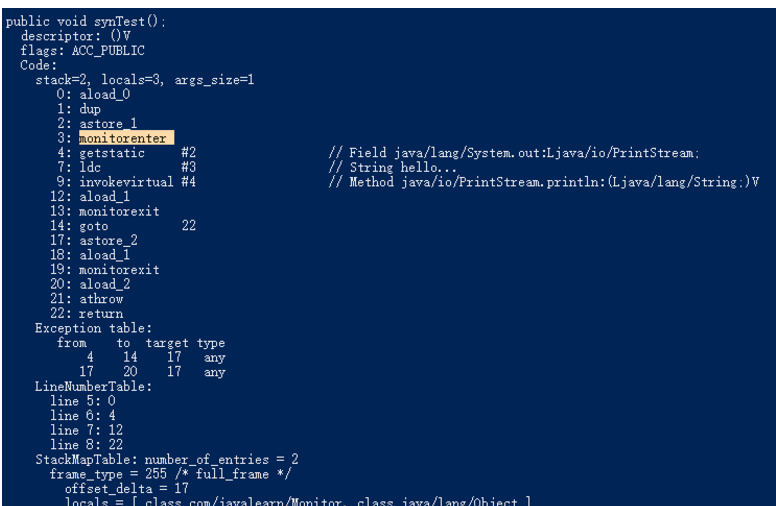
当执行到monitorenter指令时,执行方法的线程必须先获取到改对象的监视器(Monitor对象)才能进入同步块或者同步方法,而没有获取到监视器的线程会被阻塞在入口处,进入BLOCKED状态
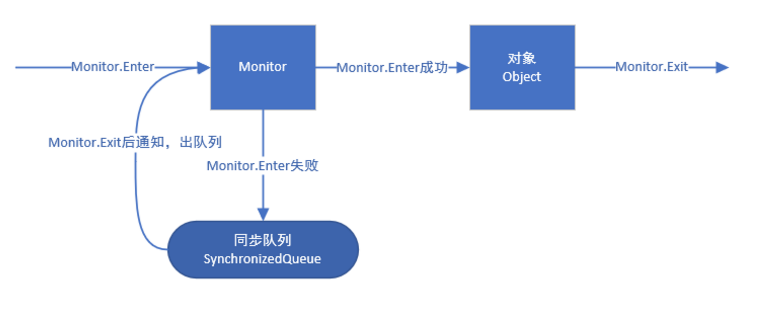
synchronize与wait/notify配合实现等待/通知
代码示例:
public class WaitNotify { static volatile boolean flag = true; static Object lock = new Object(); public static class Wait implements Runnable{ public void run() { synchronized(lock) { while(flag) { System.out.println("time1:"+currentTime()); try { lock.wait();//wait线程进入等待队列 } catch (InterruptedException e) { // TODO Auto-generated catch block e.printStackTrace(); } System.out.println("time2:"+currentTime()); } System.out.println("time3:"+currentTime()); } } } public static class Notify implements Runnable{ public void run() { synchronized(lock) { System.out.println("time4:"+currentTime()); lock.notify();//通知后,wait线程从等待队列进入同步队列,所以即使调用notify后,wait线程也是无法获取锁的 flag = false; sleepSeconds(5); } synchronized(lock) { System.out.println("time5:"+currentTime()); } } } public static void sleepSeconds(int time) { try { Thread.sleep(time*1000); } catch (InterruptedException e) { e.printStackTrace(); } } public static String currentTime() { Date date = new Date(); SimpleDateFormat format = new SimpleDateFormat("yyyy-MM-dd HH:mm:ss"); String time = format.format(date.getTime()); return time; } public static void main(String[] args) { Thread waitThread = new Thread(new Wait(),"WaitThread"); waitThread.start(); Thread notifyThread = new Thread(new Notify(),"NotifyThread"); notifyThread.start(); } }
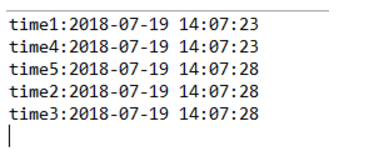
time5、time2时间有可能交换

结尾彩蛋:
i从1累加到1亿,synchronize和AtomicInteger用时对比
public class SynAtomicCompare { private int c1=0; private AtomicInteger c2 = new AtomicInteger(0); public void synAdd() { synchronized(SynAtomicCompare.class){ c1++; } } public void aicAdd() { c2.getAndAdd(1); } public void print() { System.out.println("c1:"+c1+"c2:"+c2); } public class MyThread extends Thread{ public void run() { for(int i=0;i<10000;i++) synAdd();//测试synchronized //aicAdd();//测试AtomicInteger } } public static void main(String args[]) { SynAtomicCompare t = new SynAtomicCompare(); List<MyThread> list = new ArrayList<MyThread>(); int threadNum = 10000; for(int i=0;i<threadNum;i++) { MyThread myThread = t.new MyThread(); list.add(myThread); } long start = System.currentTimeMillis(); for(int i=0;i<threadNum;i++) { list.get(i).start(); } for(int i=0;i<threadNum;i++) { try { list.get(i).join(); }catch(InterruptedException e) { e.printStackTrace(); } } long end = System.currentTimeMillis(); t.print(); long delta = end - start; System.out.println("spend time :"+delta); } }
synchronize用时3705毫秒

AtomicInteger用时2171毫秒

基于synchronize、wait、notify实现简单线程池
public class SimpleThreadPool { private static final int DEFAULT_WORKER_NUMS = 5; private List<Job> jobList = new LinkedList<Job>(); private List<Worker> workerList = new LinkedList<Worker>(); public SimpleThreadPool() { initWorkers(DEFAULT_WORKER_NUMS); } public void shutdown() { for(Worker worker : workerList) { worker.shutdown(); } } public static class Job implements Runnable{ private String jobName; private String getName() { return jobName; } public Job(String jobName) { this.jobName = jobName; } public void run() { try { Thread.sleep(1000); } catch (InterruptedException e) { e.printStackTrace(); } } } public class Worker implements Runnable{ private volatile boolean running = true; public void run() { while(running) { Job job = null; synchronized(jobList) { while(jobList.isEmpty()) { try { jobList.wait(); } catch (InterruptedException e) { // TODO Auto-generated catch block e.printStackTrace(); } } job = jobList.remove(0); } if(job!=null) { String threadName = Thread.currentThread().getName(); System.out.println(threadName+" is executing job: "+job.getName()); job.run(); } } } public void shutdown() { running = false; } } public void execute(Job job) { synchronized(jobList) { jobList.add(job); jobList.notify(); } } private void initWorkers(int num) { for(int i=0;i<num;i++) { Worker worker = new Worker(); workerList.add(worker); Thread thread = new Thread(worker,"worker-"+i); thread.start(); } } public static void main(String[] args) { SimpleThreadPool stp = new SimpleThreadPool(); for(int i=0;i<10;i++) { Job job = new Job(String.valueOf(i)); stp.execute(job); } } }
